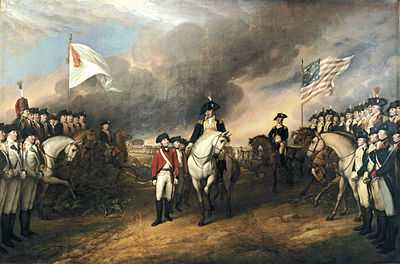Lauzun's Legion
 |
| Armed Forces |
| United States |
|---|
|
| Great Britain |
| France |
| Related topics |
Lauzun's Legion was a French regiment in the American War for Independence. Lauzun's Legion's principal engagements were at White Plains in 1781, and at the Siege of Yorktown in 1781.
Unit history
Lauzun's Legion was a specially constructed unit that was formed in March 1780 from various detachments of French and many foreign volunteers in the French army and navy. Most of the Legion was composed of units from the Volontaires Etrangers de la Marine (Foreign Marine Volunteers) created in September 1778 by the naval minister Gabriel de Sartine, and 'propriétaire' status had been granted to Armand Louis de Gontaut, due de Lauzun. The corps comprised three legions, each consisting of four companies of grenadiers, chasseurs and fusiliers, plus artillery, cavalry and pioneer detachments. As with other 18th century "legions" the intention was to create a miniature army which could campaign as a single entity. As indicated by the title, the corps was recruited primarily from German, Polish and Irish mercenaries. [1]
As the Volontaires Etrangers de la Marine, the new corps saw active service in Senegal in December 1778 as well as in the West Indies.
When in early 1781 the Expédition Particulière was being organized, most of the 1778 organization had been deployed to overseas posts. What remained in France, under the duc de Lauzun, was reconstituted as the Volontaires-étrangers de Lauzun, and was part of Rochambeau's expedition.
Lauzun's Legion in America
When the Legion arrived in America, they recruited from foreigners, mainly Hessian deserters. There were complaints about their conduct. The troops wintered in Lebanon, Connecticut. Rochambeau sent Brigadier General Marquis de Choisy with Lauzun's Legion, as they marched from Rhode Island to Head of Elk, Maryland, traveled by water to Alexandria, Virginia, and marched to Glouster Courthouse.[2]
Lauzun's Legion in Connecticut
In December 1780, two dozen Hussar horsemen deserted and discharged themselves from their winter quarters in Lebanon and fled into the woods to the south.[3] The Legion itself may have wintered in Trumbull, Connecticut, according to Huldah Hawley, who said she cooked for the French for fear they would kill her because her husband was a known Tory.[4] Lauzun's Legion or "Hussars" encamped in present-day Abraham Nichols Park in Trumbull from June 28 to June 30, 1781.[5][6] The Legion, an advance party, was ordered to protect the exposed flank of the main army and stayed 10 to 15 miles (16 to 24 km) ahead of and to the south flank of the main French army while encamped in Newtown.[7] The army was marching in the Washington–Rochambeau Revolutionary Route south to reinforce American troops under the command of General George Washington at the Siege of Yorktown.[8] French coins have since been found near the site of their camp in Abraham Nichols Park.[9]
At Yorktown
The legion was at Gloucester, Virginia, during the Siege of Yorktown. On October 4, 1781, French and British cavalry skirmished at Gloucester. The British cavalry commander, Banastre Tarleton, was unhorsed, and the Lauzun's Legion drove the British within their lines, before being ordered to withdraw by the Marquis de Choisy.[10][11][12] The Legion suffered three Hussars killed, and two officers and eleven Hussars wounded. Fifty British were killed or wounded, including Tarleton.[13]
After the battle
In December 1782, the Legion moved to Wilmington, Delaware. On 18 March 1783, in Delaware, their cash payroll was stolen but recovered.[14] On 9–11 May 1783 the Legion embarked from Wilmington on five vessels, la Goire, la Danaë, l"Astree, l'Active, and Le St. James, arriving at Brest, France, about 11 June. On 5 October 1783, the Legion's two artillery companies left Baltimore on the Duc de Lauzun, and the Pintade. The ships, guarded by two French frigates, arrived in Brest on 10 November.[15] However, many soldiers mustered out in America, or deserted.
After Lauzun returned to France, the unit became a regular hussar regiment. He remained its proprietor until the French Revolution started, and the army was reformed in the summer of 1791. When the revolutionary government declared war on Austria, the regiment fell completely apart as the majority of its officers deserted, and handed the regiment's funds, supplies, and records over to the enemy.
See also
- Armand Louis de Gontaut
- 5th Hussar Regiment
- P Street Bridge
References
- ↑ Mollo, John. Uniforms of the American Revolution. p. 216. ISBN 0-02-585580-8.
- ↑ Robert E. Selig, The Duc de Lauzun and his Legion
- ↑ Rochambeau's Cavalry: Lauzun's Legion in Connecticut 1780-1781, Robert Selig and Mary Donohue, Connecticut Historical Commission, 2000, p. 33
- ↑ History of Trumbull Dodrasquicentennial 1797-1972 p. 18
- ↑ The Magazine of American History with Notes and Queries, Vol. IV, A.S. Barnes & Co., New York, 1880, page 32
- ↑ United States Congressional Serial Set, United States Government Printing Office, December 4, 1905- June 30, 1906, Senate Documents, Washington, Vol. 32 page 396
- ↑ Life and Letters of Samuel Holden Parsons, Major General in the Continental Army and Chief Judge of the Northwestern Territory 1737 — 1789, Charles S. Hall 1905, page 364
- ↑ Newtown's History and Historian, Ezra Johnson, Newtown, CT, 1917, page 139
- ↑ History of Trumbull Dodrasquicentennial 1797-1972 p. 18
- ↑ http://www.lauzunslegion.com/History.html
- ↑ Richard M. Ketchum, Victory at Yorktown, p. 216
- ↑ The Battle of the Hook, History
- ↑ Historical Society of Pennsylvania, Extracts from the Journal of Lieutenant John Bell Tilden, The Pennsylvania Magazine of History and Biography, p.60
- ↑ The Robbery of the French Treasury
- ↑ Going Home at Last
External references
- Lauzun’s Legion Reenactors
- Lauzun's Legion's Encampment in Wilmington DE in 1782-1783
- Commemoration of the 1780 French Encampment of Lauzun's Legion at Lebanon, Connecticut, 30 September - 2 October 2005
- Robert A. Selig, The Duc de Lauzun and his Legion
- Légion's Lauzun on the Cincinnati French Society site